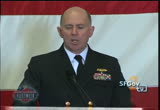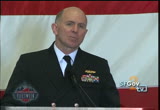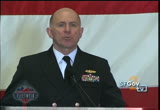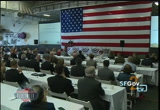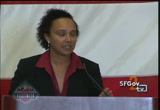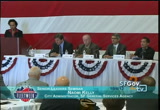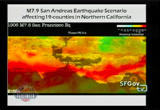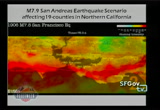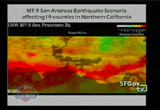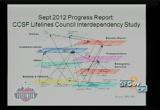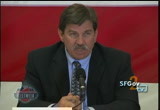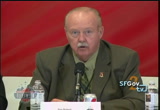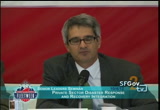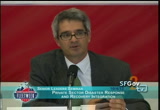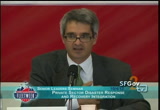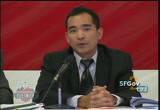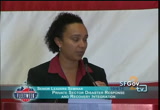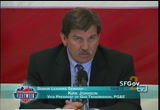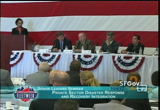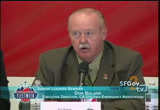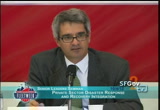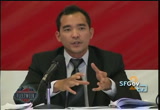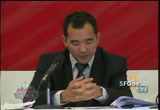tv [untitled] December 22, 2012 2:30am-3:00am PST
2:30 am
catastrophe within the confines of the san francisco bay area or perhaps in a western pacific nation or in africa or south america. i thank you in advance for the good work you are going to do. because there's going to come a point, be it an ert quake, be it a tsunami, be it a man-made heinous terrorist catastrophe, that makes a large group of people feel helpless and feel hopeless. your efforts today, your passion, your commitment, your desire to make a difference, will give help and give hope to those people. it may be your family or it may be a family across the world. it is what we do, it is what you do and i'm proud to count myself among you. so i thank you in advance for the difference you will make. i thank you in advance for putting personification and putting action into the those
2:31 am
of our country which says we will give back, we will make a difference, we will share what we know. we are global force for good. we will take what we have learned from the battlefield, which is the most traumatic and saddest way to learn about medical capability, we will take the unprecedented trauma actions that we have learned and capabilities, we will share them as is happening right now in the university of san francisco hospital system where our medical experts are sharing what they have learned on the battlefield for first responders and trauma support. we will share what we know about working with the amazing communication capabilities. northern california communication system and integrating those with our robust communication system, through dsca and the various military interagencies. we will do that, partly because it's interesting,
2:32 am
partly because it's challenges, but because as someone said all disasters are local. somewhere there's a little girl or little by or grandmother that is counting on us to get it right. so i thank you in advance for that young boy, that young girl, that family, whose lives will be changed, whose lives may even be preserved, because of your efforts. thank you for inviting me here today, thank you for allowing me to learn from you, thank you for allowing me it share a little bit about what we do and mostly to simply say thank you, it was my pleasure to be here, secretary schultz, thank you, admiral beeman, thank you. ladies and gentlemen, that's all i have. if you have any questions i'll be happy to take them.
2:33 am
response and recovery. and the moderator for this panel is the city administrator for the city and county of san francisco, naomi kelly. please help me welcome naomi kelly. (applause). >> good afternoon, everyone. thank you for having me here today. again, i'm naomi kelly, city administrator for the city and county of san francisco and it's an honor to be participating in this important panel discussion on the uss macon island. over the course of the next 50 minutes, we will
2:34 am
be going to focus one of our -- we're going to be focused on one of the most important elements of our city and that's the resill yepbs of our life line. i am joined by a prestigious panel of experts who i believe have a keen insight sbat resill yepbs of the capacities we will be relying on heavily in moving forward post a disaster. here with me today is kirk johnson, to my left, vice president of gas transmissions from pacific gas and electric. next to him is don boland, executive director of california utilities emergency association. next to him is david brig, regional and local water system manager for the san francisco public utilities commission and finally but not least, romel an jell lus,
2:35 am
manager for san francisco wireless. i have drafted several questions for our panel to answer and will hopefully have time at the end to take questions from the audience. before we start our panel discussion, i wanted it share with you what we are doing in san francisco to advance our lifeline's resilence we are the first major u.s. city to (inaudible) post katrina where he saw firsthand where a critical role these systems played in the city's recovery. i am honored to chair the council because i feel it's crucial that the public sector work side by side with our private sector partners to do everything we can today to ensure we will meet the needs of our residents in the days, weeks and years after a disaster. the objective of the
2:36 am
lifeline council are to develop and improve collaboration in the city and county across regions regularly -- to develop and improve collaboration in the city and across the region by regularly convening a group of senior level operation officers of local and regional life line providers, understanding intersystem dependencies of enhancing planning, restoration and reconstruction, share information about the recovery plans and priorities and establish coordination process for life lines restoration and recovery following a major disaster. i'm going to go back to the last slide and just say today's conversation i want to focus around the specific challenges that we're facing and that is possibly a massive earthquake along one of our several faults that pass near the bay area. this is a map of the usgs that
2:37 am
shows the potential levels of ground shaking that could be experienced across the bay area in a repeat of a major 1906-like earthquake on the san andreas fault. very strong shaking would affect most of san francisco and would last well over a minute. for context, in 1906, over 500 miles of the san andreas fault moved in a second. in 1989 in the loam loma prieta event (inaudible) understand our interdependancies and we launchd an inder dependancy study earlier this year. this will benefit all our operators as well as the region's businesses and residents. first we want to build on an understanding of all of our
2:38 am
existing system interdependancies and the consequences of existing conditions to help expedite sppbs and restoration planning among agencies. with this we will also identify the key assets and respiration of priority schemes to prioritize and restoring and rebuilding our city and ultimately the region after such an earthquake. we will then work to develop a set of life line expectation under current systems and standards developed over the next decade. you can imagine as you see from the slide behind me this visualization of a complex network of interdependancies that exist among a wide variety of life lines we count on every day. for example, a crucial role is communications will play in helping the life lines cooperate opt mately while disaster is captured in the dark blue grid on the left. additionally the mission critical need to have access for fuel to operate the
2:39 am
multiple system that deliver crucial resources to our residents' homes and businesses is displayed in the gray grid on the top left. with that, i now would like to turn to our panel to start today's conversations and once again thank you for joining us. my first question to the panel, and before we get started on answering these questions, i just want to lay a few ground rules. we'll try to keep our answers to less than 3 minutes and logistically, the microphones, only one can speak at a time and make sure we're not speaking over each other. my first question: what efforts are your organization making today and how are you cooperating with each other to
2:40 am
address multi (inaudible). >> what we produce at pg&e we are very aware what's expected of us. we serve a huge part of central and northern california so while we're talking to a great extent about san francisco today, most of the activity is very regionally based and most of the energy that comes into san francisco is piped in from other places so we have to look at everything from a regional perspective. in terms of what we're doing with our infrastructure, we look at many risks to our systems to improve their reliability, both gas and electric. while we talk about earthquakes quite a bit, we look more at ground movement in general, whether it be earthquake related, land slide related, but in terms of our reliability all those risks are
2:41 am
looked at and there's on-going efforts to increase the reliability of both the electric system and the gas system throughout the san francisco area and through the northern and system part of our state. we have hundreds of millions of dollars of pipeline replacement happening which is a major risk in a major earthquake. most people are aware in loma prieta the pipeline held pretty well but we are trying to build in a better manner to withdraw earthquakes. on the electric side, things are pretty well proat the timed already. things shut themselves off. depending on the magnitude of the earthquake, it could take up to 12 hours to get power back on
2:42 am
really it's going to depend how fast we can get to the facility. that's one of the things we have to work with, with government officials and others, how do we get to the facilities to fix them. in terms of an emergency response stand point, we have stand by back ups, we have stand by centers, we can operate an emergency center in san francisco out of walnut creek, out of san ramon, almost anywhere in the state if we choose to. in terms of working with local governments, we are members of many state, federal and local emergency response organizations. again we're a regional company so it's not just about one general location, it's about serving every one of our local service areas whether it's san francisco or the san joaquin valley. >> thank you, mr. boland. >> we fill a little different role. we don't have any
2:43 am
infrastructure but we represent utilities that have 88 percent of the infrastructure that keep our populations running. we cover from the mexican border to oregon and what we facilitate through the organization is we are embedded with the state of california through the last 60 years. we are in the cali complex, we have an mou with the secretary of cali and can bring resources from other companies in the field across all the disciplines for mutual assistance. we can stage, deploy and sit on situational awareness providing the state the information they need to posture a response and at the same time we can then be putting together the teams that are going to have to come in and support pg&e or other utilities that are in the stricken zone. we'll be calling on organizations from san diego to redding, we'll be calling on organizations outside the state of california that we have mou's with out of
2:44 am
nevada and other surrounding states so that in the event an incident of this magnitude happens there is sufficient response personnel notified postured and deployed to keep a continuous line of assistance from the private municipal sector moving into the stricken area in san francisco to support and reconstitute those life lines across all disciplines, telecommunication, water, waste water, gas and energy. >> thank you. mr. brig. >> good afternoon. when we talk about resill yepbs and resiliency for the san francisco public works, the sfpuc not only provides those life lines to san francisco, but we also operate the hetch hetchy regional water system that supplies a great amount of
2:45 am
water for a large part of the bay area, 2 1/2 million customers. and for a regional supplier like ourselves when resiliency comes sbat conversation you are talking about earthquakes come up already and terrorism as well and we've done a lot to put our money where our mouth is. we are right in the middle of investing 4 1/2 billion dollars in our water system. most of that is in the regional transition system, but about a billion of that is in san francisco itself and i can tell you that to put your money where your mouth is and really tackle capital investment when you talk about resiliency, it starts and ends there with capital investment. to be able to put your money where your mouth is, you have to convince your rate payer base that they want it and they can afford it and there's a whole exercise there in parallel. the investment is the usual thing. we're making things stronger, we have earthquakes that we design for, everything
2:46 am
is more robust. we have 3 active faults in the bay area that our system crosses. it is not an insignificant engineering challenge it cross a fault that can move 8 feet, when your pipe is 72 inches or more in diameter, to cross a fault when your pipe is moving 8 feet in a sheer motion is not something a normal pipe can do. we have some of the most sophisticated fault crossings in the world right now in the bay area. some of the investment is geared towards creating more ipblds for our water facility. i realize the name of the game today is about coordination and cooperation and when i speak about independence i'm not talking about both sides of my mouth here, but being independent, steering some of
2:47 am
our stuff to satellite phones, no offense, our verizon friends, and our pg&e friends, we're not going to count on when things get bad. steering some of this investment to independent providers we are not planning on depending on anybody. not only does that make easier for me keeping more things under my control, it makes things easier for them because they will have one less person calling them. even though it's all about cooperation, sometimes independence comes into the conversation. the last thing i would touch on is it's personal. by that i mean i know a lot of people in this room i can call and depend on if there's an emergency in san francisco. they know me, they know what i do, i saw them all the time, we know what our roles are. we had a little mini exercise about a month ago with a minor pipe break in san francisco where we exercised
2:48 am
these relationships. i won't talk about all the meet and greet opportunities to get to know each other. i won't go into detail on all the areas, but we do work together on a lot of forums and it does come down to relationships in a lot of these areas of cooperation. >> thank you. mr. angelus. >> good afternoon. we at verizon wireless we believe our most important responsibility to make sure our network is not only available, but reliable. so to address the question of resiliency, i would like to cover 3 important points that we do day-to-day to make sure our network is available and ready to use for the public. no. 1 is back-up systems. so just to give you a brief idea of how our network works, we have two major components of our network, we have our cet
2:49 am
sites and our switches. in our cet sites, in all of our cell sites, we actually have batteries to account for power out ages. that's 8 hour back-up time for our batteries and in addition, most of our cell sites actually have back-up generators as well. we have about 4 days of stand by time to about maybe 10 days and then on top of that we have vendors that we work with that are on stand by to make sure that we can refuel our cell sites and also maintain them if our generators do go out of service. and then as far as our switches, so the switches are control centers that manage all our cell sites. we have about 300 cell sites per switch and in the bay area we have about 4 switches. what we have there is also back-up power so we have batteries, we have
2:50 am
generators, not only one generator, sometimes we have 3 generators to account for failure for one of those generators. then in these switchers we have servers, fiber optics, all kinds of equipment to process calls from one point to another and we have back-up systems on top of back-up systems to support that. every failure point pretty much is addressed in the design of our network. one thing that's important to mention as well is not only to make sure the network is available to handle calls but also do we have enough capacity to support surges of traffic? so in cases of emergency, did we have the resources available for that? well, no network is perfect that can handle unlimited amount of traffic. our network can handle about 200 to 300 percent increase of traffic for emergency situations. the last thing i wanted to pipbt out as far as partnership
2:51 am
with our local government, the way that our organization works, we have a regional approach to our operation. so that way we can actually be closely tied in to all the regional offices and local governments that we work with. so that way we can establish relationships, in fact we work very closely with don's group in all the emergency situations in the past summer for all the wild fire scenarios in california we work closely with his group to make sure we can respond quickly to these questions. thank you. >> thank you. all right, our second question, what strategies do you have in place to avoid any long-term interruption of services to our residents and private sector partners and have you tested them in a meaningful way to ensure their effectiveness? shall we start with you, mr. johnson? >> i'd be happy to start. in terms of testing for their effectiveness, they are tested
2:52 am
almost every day with pg&e service territory we probably have 80 electrical outages every day. we have opportunities to test our emergency centers on a regular basis and in fact there's an emergency center open today just for some of the work that's happening throughout the service territory. so in terms of just our effectiveness it's something we do each and every day, unfortunately it's something we do every day but at least it's there. our infrastructure, we don't want to have outages, we design so we minimize that damage but we always know there will be things mother nature throws at us that we can't design around whether it's an earthquake or a major storm. we get challenged with major storms throughout the service territory so it's not unusual that a major storm comes by every year and takes out about a fifth of our base. we have
2:53 am
service responders on our own teams well in excess of a hundred a year. in terms of preparedness, we have emergency pipe yards, we have emergency stand by facilities, we have vendors who are on emergency stand by so those facilities, the material we might need, we have plenty of it and it's stored throughout the entire service territory. we have 3 major services, supply service chains, that are open and available to us 24/7 if we need them. we also have contractor arrangements, maybe it's pipeline welding or electrical service work, line man work, and we also have mutual service agreements and pg&e participates in those. we have sent folks to hawaii and we have sent folks back east and we have certainly sent folks to oregon and washington and idaho on a regular basis as we all in the west suffered through storms. so we have those
2:54 am
activities in place and then of course we do just our normal emergency response activations on an on-going basis just to make sure everyone is trained and veilable and ready to go. in terms of the big 1 that we always talk about, we have an earthquake play book. the gas side and electric side has very specific actions to take, we have very trat strategic actions to take, we have a hard copy and hopefully we'll never need it but if a big earthquake comes, it can happen anywhere in the stais, there's earthquake faults all over this place, we're ready to go. >> mr. boland. >> we take a little different role on this seeing as we represent a multiple discipline of utilities, we are engaged in california national guard in their exercises. we handle the
2:55 am
utility operations center which is wholly operated within the state's operation center. we do the exercises with calima to golden guarden all the way down to the specific exercises. we interface with each and every one of our utilities and their exercise programs. we carry the best practices from one utility to the next to share that knowledge across discipline. we then execute decisions on the catastrophic plan for california, the one coming up here in the bay area so all utilities understand their role that needs to be played and we can plug and play and the class ral utilities that are going to be called upon to support it from the private and municipal side and this is an on-going living process. working with the local jurisdictions, the county
2:56 am
jurisdictions always, the states north and south and the state operations center and then supporting whatever the fema initiatives are moving out from that in cross-discipline lines. >> thank you. mr. brig. >> as an operator of a distribution system, the stories are probably very similar. we have small emergencies every day, small, medium and even large, so the back-up systems, the screening, the ics structure, the spare parts, the communication, those muscles are flexed quite often. the big one is the one we design for and spend a lot of our time and energy preparing for. the big one for us is the design earthquake, it's the max credible earthquake, san an drais a is basically a 8.0, a repeat of the 1906 earthquake. some of the components can be tested, we can simulate an earthquake on some of these
2:57 am
facilities as they are in design to make sure they can withdraw that level of earthquake. we're designing for an 8.0 and that's not what happened in japan in 2011. the earthquake that hit japan in 2011 was not what they were designing for and all the assumptions went out the window so that's food for thought. >> thank you. mr. angelus. >> at verizon wireless we try to do it day in and day out to avoid interruption in services. we try to put all this in place but in the event they do happen, we have those redundant systems i discussed earlier. weak route traffic from one side to another or from one switch to another and we test regularly to make sure they occur. and this is transparent
2:58 am
to our customers. calls are being routed to another switch during these cross over tests. we have actually fleet of portable cell sites, these are cells that are on trucks or in trailers that are deployed, that actually are available within a market so we can deploy them in the cases of emergency so if the cet site actually goes out of service, we can deploy a september temporary cell site. we have these systems available for our emergency departments so if they need coverage in certain areas that are not covered very well, they can actually use those systems as well. so i did talk about the failure overcasts. i think this is the key portion of our industry, for our company. we
2:59 am
want to make sure that we can take into account when these big situations occur and major interruptions happen in particular areas. >> thank you. okay, our last question, have you established standards for resilience in cooperation with other lifeline providers and how systems should perform in an earthquake? >> i'll go ahead and talk about pg&e. i would say first off we've designed our own standards for what should happen in an earthquake or any other major emergency. our electric system is designed to worry about trees and wind and rain, which is what we see the most of, and tends to be the most damaging, but we have our own standards and our own expectations in terms of what our system should be able to withstand.
122 Views
IN COLLECTIONS
SFGTV2: San Francisco Government Television Television Archive
Television Archive  Television Archive News Search Service
Television Archive News Search Service 
Uploaded by TV Archive on

 Live Music Archive
Live Music Archive Librivox Free Audio
Librivox Free Audio Metropolitan Museum
Metropolitan Museum Cleveland Museum of Art
Cleveland Museum of Art Internet Arcade
Internet Arcade Console Living Room
Console Living Room Books to Borrow
Books to Borrow Open Library
Open Library TV News
TV News Understanding 9/11
Understanding 9/11